The internal structure of MOSFET and IGBT is different, which determines the difference in its application field.
1, due to the structure of the MOSFET, usually it can achieve a large current, can go to the KA, but the premise pressure resistance is not strong IGBT.
2, IGBT can do a lot of power, current and voltage can be, that is, a little frequency is not too high, the current IGBT hard switching speed can be up to 100KHZ, that is already good. But compared to the MOSFET's operating frequency is still a spur, MOSFET can work To hundreds of KHZ, MHZ, and even tens of MHZ, RF products.
3, according to its characteristics, according to its characteristics: MOSFET is used in switching power supply, ballast, high frequency induction heating, high frequency inverter welding machine, communication power supply and other high frequency power supply fields; IGBT is mainly used in welding machines, inverters , inverter, electroplating electrolysis power supply, super audio induction heating, etc.
The performance of Switch Mode Power Supply (SMPS) depends to a large extent on the choice of power semiconductor devices, namely switching transistors and rectifiers.
Although there is no perfect solution to solve the problem of selecting IGBT or MOSFET, the performance comparison of IGBT and MOSFET in specific SMPS applications can determine the range of key parameters.
This article will discuss some of the parameters, such as switching losses in hard-switching and soft-switching ZVS (Zero-Voltage) topologies, and the three main power switching losses associated with circuit and device characteristics—conduction loss, conduction loss, and turn-off. Loss is described. In addition, by illustrating the recovery characteristics of the diode is the main factor determining the conduction switching loss of the MOSFET or IGBT, the influence of the diode recovery performance on the hard switching topology is discussed.
Conduction loss
In addition to the longer voltage drop time of the IGBT, the turn-on characteristics of the IGBT and the power MOSFET are very similar. It can be seen from the basic IGBT equivalent circuit (see Figure 1) that the time required to fully adjust the minority carriers of the base region of the PNP BJT collector results in a voltage tail appearing.
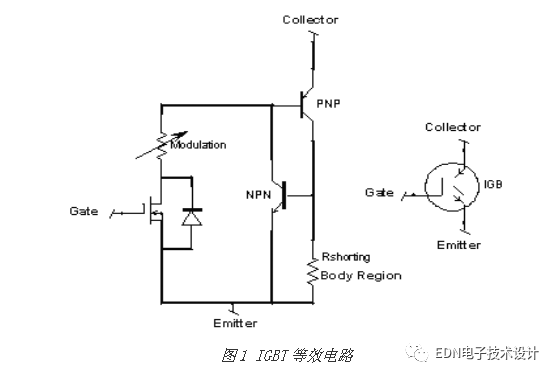
This delay causes a quasi-saturation effect that prevents the collector/emitter voltage from dropping immediately to its VCE(sat) value. This effect also results in the VCE voltage rising at the moment when the load current is switched from the anti-parallel diode of the combined package to the collector of the IGBT in the ZVS case. The Eon energy consumption listed in the IGBT product specification is the time integral of the product of the Icollector and VCE for each conversion cycle, in joules, and contains other losses associated with class saturation. It is further divided into two Eon energy parameters, Eon1 and Eon2. Eon1 is the power loss that does not include the energy associated with the recovery of the hard-switched diode; Eon2 includes the hard-switching conduction energy associated with diode recovery, which can be measured by restoring the same diode as the diode of the IGBT package. Typical The Eon2 test circuit is shown in Figure 2. The IGBT measures Eon by switching between two pulses. The first pulse will increase the inductor current to achieve the desired test current, and then the second pulse will measure the Eon loss that the test current recovers on the diode.
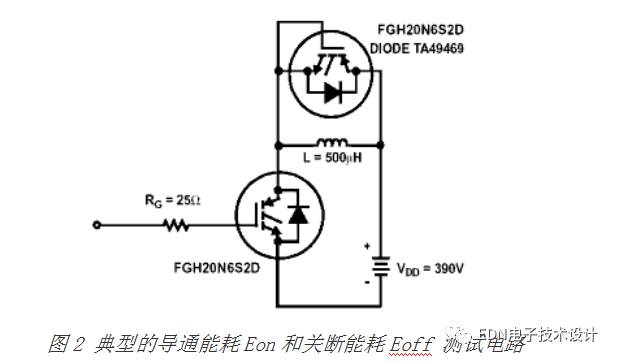
In the case where the hard switch is turned on, the gate drive voltage and impedance and the recovery characteristics of the rectifier diode determine the Eon switching loss. For a conventional CCM boost PFC circuit, the boost diode recovery characteristics are extremely important in the control of Eon energy consumption. In addition to selecting a boost diode with a minimum of Trr and QRR, it is also important to ensure that the diode has soft recovery characteristics. Softness, the tb/ta ratio, has a considerable effect on the electrical noise generated by the switching device and the voltage spike. Some high speed diodes have a high rate of current drop (di/dt) from IRM (REC) during time tb, which can result in high voltage spikes in the parasitic inductance of the circuit. These voltage spikes can cause electromagnetic interference (EMI) and can cause excessive reverse voltages on the diode.
In hard-switching circuits, such as full-bridge and half-bridge topologies, the combination with the IGBT is a fast recovery transistor or a MOSFET body diode. When the corresponding switching transistor is turned on, the diode has a current, and the recovery characteristics of the diode determine Eon. loss. Therefore, it is important to choose a MOSFET with fast body diode recovery. Unfortunately, the parasitic diode or body diode recovery characteristics of the MOSFET are slower than the discrete diodes currently used in the industry. Therefore, for hard-switching MOSFET applications, body diodes are often the limiting factor in determining the operating frequency of the SMPS.
In general, IGBT packaged diodes are chosen to match their application, with slower ultrafast diodes with lower forward conduction losses combined with slower low VCE (sat) motor drive IGBTs. Conversely, soft-recovery ultrafast diodes can be packaged in combination with high-frequency SMPS2 switch-mode IGBTs.
In addition to choosing the right diode, the designer can also control the Eon loss by adjusting the gate drive source impedance. Reducing the drive source impedance will increase the conduction di/dt of the IGBT or MOSFET and reduce the Eon loss. Eon loss and EMI need to be compromised because higher di/dt leads to increased voltage spikes, radiation, and conducted EMI. In order to select the correct gate drive impedance to meet the turn-on di/dt requirements, internal circuit testing and verification may be required, and then the approximate value can be determined from the MOSFET conversion curve (see Figure 3).

Assume that the FET current rises to 10A when turned on. According to the curve of 25°C in Figure 3, in order to reach the value of 10A, the gate voltage must be converted from 5.2V to 6.7V, and the average GFS is 10A/(6.7V- 5.2V) = 6.7mΩ.

Equation 1 obtains the gate drive impedance required to conduct di/dt
Apply the average GFS value to Equation 1, and obtain the gate drive voltage Vdrive=10V, the required di/dt=600A/μs, the FCP11N60 typical value VGS(avg)=6V, Ciss=1200pF; then the conduction can be calculated. The gate drive impedance is 37Ω. Since the transient GFS value in the curve of Figure 3 is a diagonal line, it will change during Eon, meaning that di/dt will also change. The exponentially decaying gate drive current Vdrive and the falling Ciss also enter this equation as a function of VGS, exhibiting an overall effect with surprising linear current rise.
Similarly, the IGBT can also perform similar gate drive on-resistance calculations. VGE(avg) and GFS can be determined by the conversion characteristic curve of the IGBT, and the CIES value under VGE(avg) is used instead of Ciss. The calculated IGBT turn-on gate drive impedance is 100Ω, which is higher than the previous 37Ω, indicating that the IGBT GFS is higher and the CIES is lower. The key point here is that the gate drive circuit must be adjusted in order to switch from MOSFET to IGBT.
Conduction losses need to be cautious
When comparing devices rated at 600V, the conduction losses of IGBTs are generally less than the 600 V MOSFETs of the same chip size. This comparison should be made at the collector and drain current densities and can be performed at the worst-case operating junction temperature. For example, both the FGP20N6S2 SMPS2 IGBT and the FCP11N60 SuperFET have an RθJC value of 1 °C/W. Figure 4 shows the conduction loss vs. DC current at a junction temperature of 125 °C. The plot shows that the MOSFET has a higher conduction loss after the DC current is greater than 2.92A.
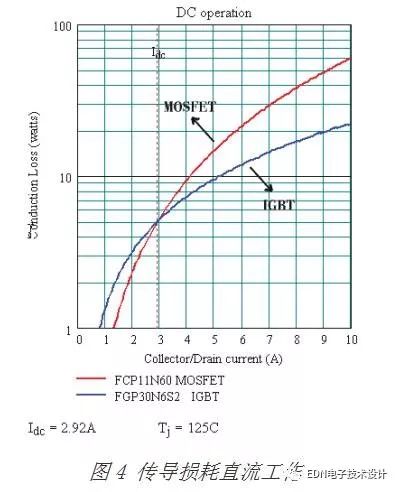
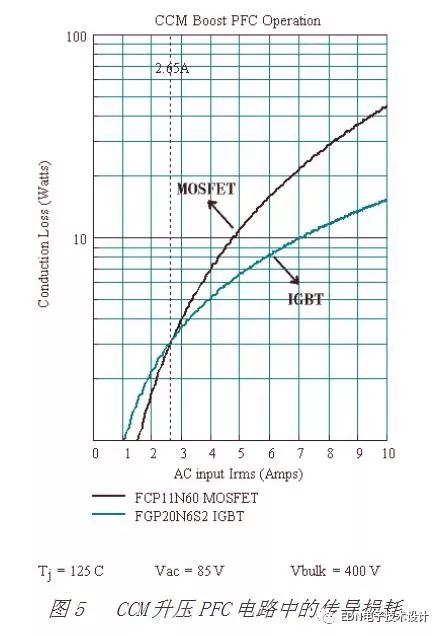
However, the DC conduction losses in Figure 4 are not suitable for most applications. At the same time, a comparison curve of conduction loss in CCM (continuous current mode), boost PFC circuit, junction temperature of 125 ° C, and AC input voltage Vac and 400 Vdc DC output voltage of 85 V is shown in Figure 5. In the figure, the MOSFET-IGBT curve intersection point is 2.65A RMS. For PFC circuits, the MOSFET has a large conduction loss when the AC input current is greater than 2.65A RMS. The 2.65A PFC AC input current is equal to the 2.29A RMS calculated by Equation 2 in the MOSFET. The MOSFET conduction loss, I2R, can be calculated using the current defined by Equation 2 and the RDS(on) of the MOSFET 125°C. Taking into account the variation of RDS(on) with the drain current, the conduction loss can be further refined. This relationship is shown in Fig. 6.
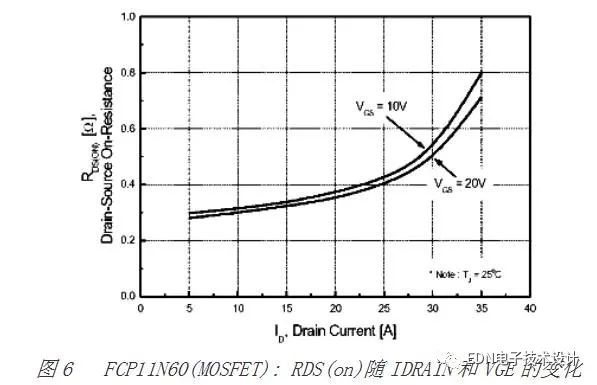
An IEEE article entitled "How to Incorporate the RDS(on) of a Power MOSFET to the Drain Current Transient Value into the Conduction Loss Calculation of a High-Frequency Three-Phase PWM Inverter" describes how to determine the drain current. The effect on conduction losses. As a function of ID, RDS(on) changes have little effect on most SMPS topologies. For example, in a PFC circuit, when the peak current ID of the FCP11N60 MOSFET is 11A—doubled to 5.5A (the test condition for RDS(on) in the specification), the effective value and conduction loss of RDS(on) increase by 5. %.
In the high pulse current topology where the MOSFET conducts very small duty cycles, the characteristics shown in Figure 6 should be considered. If the FCP11N60 MOSFET is operating in a circuit whose drain current is a 20A pulse with a duty cycle of 7.5% (ie 5.5A RMS), then the effective RDS(on) will be greater than 5.5A (test current in the specification). 0.32 ohms is 25% larger.

Equation 2 RMS current in CCM PFC circuit
In Equation 2, Iacrms is the RMS input current of the PFC circuit; Vac is the RMS input voltage of the PFC circuit; Vout is the DC output voltage.
In practical applications, calculating the conduction losses of IGBTs in similar PFC circuits will be more complicated because each switching cycle is performed on a different IC. The VCE(sat) of an IGBT cannot be represented by an impedance. A relatively straightforward method is to represent it as an impedance RFCE in series with a fixed VFCE voltage, VCE(ICE) = ICE × RFCE + VFCE. Thus, the conduction loss can be calculated as the product of the average collector current and VFCE, plus the square of the RMS collector current, multiplied by the impedance RFCE.
The example in Figure 5 only considers the conduction losses of the CCM PFC circuit, assuming that the design goal is to maintain a worst case conduction loss of less than 15W. Taking the FCP11N60 MOSFET as an example, the circuit is limited to 5.8A, while the FGP20N6S2 IGBT can operate at 9.8A AC input current. It can conduct more than 70% of the power of the MOSFET.
Although the conduction loss of IGBTs is small, most 600V IGBTs are PT (Punch Through) type devices. PT devices have NTC (negative temperature coefficient) characteristics and cannot be shunted in parallel. Perhaps these devices can be paralleled with limited effectiveness through matching devices VCE(sat), VGE(TH) (gate threshold voltage), and mechanical packaging to allow consistent temperature variations in IGBT chips. Conversely, MOSFETs have a PTC (Positive Temperature Coefficient) that provides good current shunting.
Shutdown loss - the problem is not over yet
In hard-switching, clamp-inductive circuits, the turn-off loss of the MOSFET is much lower than that of the IGBT due to the tail current of the IGBT, which is related to the removal of the minority carriers of the PNP BJT in Figure 1. Figure 7 shows a function Eoff of collector current ICE and junction temperature Tj, the curve of which is provided in most IGBT data sheets. These curves are based on clamped inductive circuits and have the same test voltage and contain tail current energy losses.
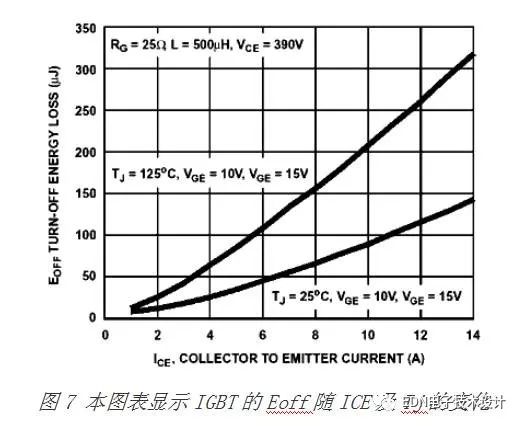
Figure 2 shows a typical test circuit for measuring IGBT Eoff. Its test voltage, VDD in Figure 2, varies from manufacturer to manufacturer and from individual device BVCES. VDD in this test condition should be considered when comparing devices, as testing and operation at lower VDD clamp voltages will result in reduced Eoff power consumption.
Reducing the gate drive turn-off impedance has minimal effect on reducing the IGBT Eoff loss. As shown in FIG. 1, when the equivalent majority carrier MOSFET is turned off, there is still a storage time delay td(off) I in the IGBT minority carrier BJT. However, lowering the Eoff drive impedance will reduce the risk of the current caused by the Miller capacitance CRES and the dv/dt turning off the VCE into the gate drive loop, avoiding re-biasing the device to a conducting state, resulting in Multiple switching actions that produce Eoff.
The ZVS and ZCS topologies have advantages in reducing the turn-off losses of MOSFETs and IGBTs. However, the working advantage of ZVS is not so large in the IGBT, because the tailing surge current Eoff is caused when the collector voltage rises to a potential value that allows excess stored charge to be dissipated. The ZCS topology boosts maximum IGBT Eoff performance. The correct gate drive sequence allows the IGBT gate signal to not be cleared before the second collector current zero crossing, thereby significantly reducing the IGBT ZCS Eoff.
The Eoff energy dissipation of a MOSFET is a function of its Miller capacitance Crss, gate drive speed, gate drive turn-off source impedance, and parasitic inductance in the source power circuit path. The circuit's parasitic inductance Lx (shown in Figure 8) produces an electrical potential that increases the turn-off loss by limiting the current speed drop. At turn-off, the current drop rate di/dt is determined by Lx and VGS(th). If Lx = 5nH and VGS(th) = 4V, the maximum current falling speed is VGS(th) / Lx = 800A / μs.
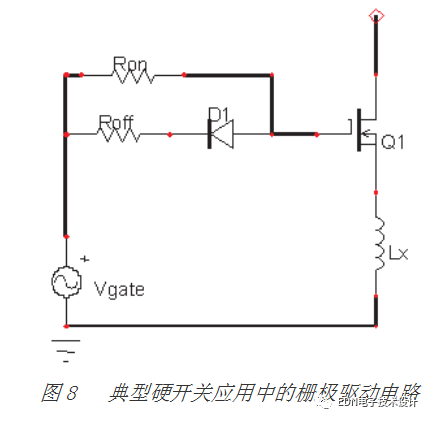
to sum up:
When choosing a power switching device, there is no one-size-fits-all solution, circuit topology, operating frequency, ambient temperature, and physical size, all of which will play a role in making the best choice.
In ZVS and ZCS applications with minimal Eon loss, MOSFETs can operate at higher frequencies due to faster switching speeds and less turn-off losses.
For hard-switching applications, the recovery characteristics of MOSFET parasitic diodes can be a disadvantage. In contrast, because the diodes in the IGBT package are matched to the specific application, an excellent soft recovery diode can be matched to the higher speed SMPS device.
There is no essential difference between MOSFE and IGBT. The question of whether MOSFET is good or IGBT is often wrong. As for why we sometimes use MOSFETs and sometimes MOSFETs without MOSFETs, we can't simply distinguish between good and bad. To judge, we need to use a dialectical method to consider this problem.
Antenk Card SIM Connectors are precision engineered PCB mount connectors developed to mate with the plated fingers of a printed circuit daughter board. Their bifurcated, cantilever contacts are set in a dual readout configuration and they offer a reliable connection for a wide range of PCB thicknesses. Antenk`s sturdy solder tails with tapers allow easy insertion and rugged durability
SIM Card Connectors Introduction
SIM card connectors designed for applications requiring two or more pcb`s to be connected and readily removed.
As the market trends towards versatility, customers need flexible high-speed edge card receptacles that can be utilized across as many platforms as possible. Through creating industry standards by collaborating with customers, Antenk is committed to offering a wide range of edge card receptacles that can be used in multiple applications across one solution.
Flexible Solutions Solving Many Problems
Antenk Edge Card Connector Solutions solve many problems across a wide range of circuit sizes, configurations, pitch, and PCB-attach terminations. Scroll down list to see more on our full line of edge card solutions.
Types of Card Edge Connectors
AMC / AMC B+ Connectors
Micro TCA Connectors
PCI Express / PCI Connectors
Standard Card Edge Connectors
Edgecard PCB Connectors Range
SIM Card Connector,Pci Card Edge Connector,Pitch Card Edge Connector,Pcb Edge Card Connector,AMC / AMC B+ Connectors,Micro TCA Connectors,PCI Express / PCI Connectors,Standard Card Edge Connectors
ShenZhen Antenk Electronics Co,Ltd , https://www.antenkwire.com
